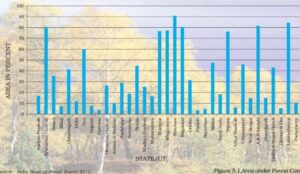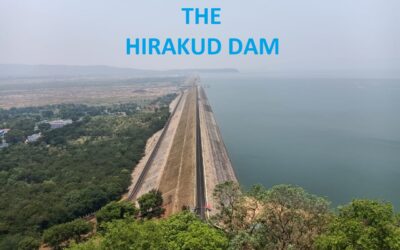Case Study Based Questions – Term II From Natural Vegetation & Wildlife: Class IX
Natural Vegetation and wildlife Case Study Based Questions for class IX term II will be a special attraction in this years Geography question paper. Therefore, 8 case study based questions have been prepared in this blog so that students can score full 4 marks. Although, Case Case Study Based Questions are not difficult, but, it checks your concept. By going through these 8 case study based questions from Natural Vegetation and wildlife, you will get an idea to prepare for Term II examination. In Geography, case study based questions will come from climate and Natural vegetation. For case study based questions from climate, click on the given link. TERM II CLASS IX – GEOGRAPHY WORKSHEET ON CLIMATE – SOLVED
I. Read the following passage and answer the questions that follows:
Our country India is one of the 12 mega bio-diversity countries of the world. With about 47,000 plant species India occupies tenth place in the world .and fourth in Asia. There are about 15,000 flowering plants in India. Moreover, it also has approximately 90,000 species of animals as well as many varieties of fishes. Natural vegetation refers to a plant community, which has grown naturally without human aid and has been left undisturbed by humans for a long time. This is termed as a virgin vegetation. Thus, cultivated crops and fruits, orchards form part of vegetation but not natural vegetation. The virgin vegetation, which are purely Indian are known as endemic or indigenous species but those which have come from outside India are termed as exotic plants.
Question1.
Why is India among the 12 mega bio-diversity countries of the world? 1.
Question 2.
What is virgin vegetation? 1.
Question3.
Define endemic and exotic plants. 2.
Solutions:
Ans 1.
Firstly, India has about 47000 species of plants out of which 15000 are flowering plants.
Moreover, it also has 90000 varieties of animal species.
Therefore, wide verities of flora and fauna make India among the 12 mega bio-diversity countries of the world.
Ans 2.
Virgin vegetation refers to the Natural vegetation.
It is a type of vegetation which grows naturally and grows without human interference.
Ans 3.
Endemic plants: It is the natural vegetation, which is purely Indian.
It is exclusively found in India.
Therefore, such vegetation is known as endemic species.
Exotic plants: The plants which have come from outside India are called exotic plants.
Natural Vegetation And Wildlife : Case Study Based Questions – Term II
II. Read the following passage and answer the questions that follows:
Forests are renewable resources and play a major role in enhancing the quality of environment. Moreover, they modify local climate, control soil erosion, regulate stream flow, support a variety of industries. Not only that, it also provide livelihood for many communities and offer panoramic or scenic view They control wind force and temperature and cause rains. They provide humus to the soil and shelter to the wildlife. India’s natural vegetation has undergone many changes due to several factors, such as the growing demand for cultivated land, development of industries and mining, urbanization and over-grazing of pastures.
Question1.
How do forests help in enhancing the quality of environment? 1.
Question 2.
India’s natural vegetation has undergone many changes. Comment. 1.
Question 3.
How are forests important for human beings? 2.
Solutions:
Ans 1.
Forests play a major role in enhancing the quality of environment.
Forests control soil erosion, regulates temperature, causes rainfall, absorbs carbon di oxide and releases oxygen.
This is how, it plays a major role in enhancing the quality of environment.
Ans 2.
Earlier, India was a country with dense and a wide variety of natural vegetation.
But, today natural vegetation has undergone many changes .
It is due to the development of agricultural land, industries, mining, urbanization etc.
Ans 3.
Forests are important for human beings in many ways such as:
Firstly, It provides timber for industries.
Secondly, We get many forest products such as rubber, lac, resin etc.
Thirdly, provide livelihood for many communities.
Finally, modifies temperature, recharges underground water and causes rainfall.
Natural Vegetation And Wildlife : Case Study Based Questions – Term II
III. Read the following data and answer the questions that follows:

Case study based questions from Natural vegetation and wildlife. Image courtesy: NCERT CLASS IX TEXT BOOK.
III. Study the bar graph and answer the following questions:
Question1.
Name the state having maximum area under forest cover.
Question 2.
Which union territory has minimum area under forest cover and why?
Question 3.
According to India State of Forest Report 2011, what is the forest cover in India ? Mention two factors for its depletion.
Solutions:
Ans 1.
Mizoram is the state with above 90 percent area under forest cover.
Ans 2.
Daman and Diu is the union territory with minimum area under forest cover.
It is because its area is small and it is not possible to expand forest area.
Ans3.
According to Indian State of forest-report-2011, area under forest cover is 21.05 per cent.
Two factors for its depletion are:
i) Firstly, Expansion of agricultural land and
ii) Secondly, Urbanization.
Natural Vegetation And Wildlife : Case Study Based Questions – Term II
IV. Read the following passage and answer the questions that follows:
These forests are restricted to heavy rainfall areas of the Western Ghats. They are at their best in areas having more than 200 cm of rainfall with a short dry season. The trees reach great heights up to 60 metres or even above. Since the region is warm and wet throughout the year, it has of all kinds — trees, shrubs and creepers giving it a multilayered structure. There is no definite time for trees to shed their leaves. As such, these forests appear green all the year round. Some of the commercially important trees of this forest are ebony, mahogany, rosewood, rubber and cinchona.
Question1.
Which forests are mentioned in the above paragraph?
Question 2.
Why do these forests appear green throughout the year?
Question 3.
These forests are commercially not very useful. Give two reasons.
Solutions:
Ans 1.
Tropical rain forest is also known as evergreen forests.
Ans 2.
These forests appear green throughout the year because they do not shed their leaves altogether.
Ans 3.
These forests are commercially not very useful. Two reasons are:
i) Firstly, As these forests are very dark, it is difficult to identify the trees.
ii) Secondly, The forests are very dense, so it is difficult to enter.
You may like to read:
Assam Tea Gardens Have Their Own Time मेघालय : रैट होल माइनिंग
Natural Vegetation And Wildlife : Case Study Based Questions – Term II
V. Read the following passage and answer the questions that follows:
These are the most widespread forests of India. They are also called the monsoon forests and spread over the region receiving rainfall between 200 cm and 70 cm. Trees of this forest type shed their leaves for about six to eight weeks in dry summer. On the basis of the availability of water, these forests are further divided into moist and dry. The former is found in areas receiving rainfall between 200 and 100 cm. These forests exist, therefore, mostly in the eastern part of the country — northeastern states, along the foothills of the Himalayas, Jharkhand, West Odisha and Chhattisgarh, and on the eastern slopes of the Western Ghats. https://whc.unesco.org/en/list/1342/ Teak is the most dominant species of this forest. Bamboos, sal, shisham, sandalwood and mulberry are other commercially important species.
Question1.
Which forests are mentioned in the paragraph?
Question 2.
When and why do these forests shed their leaves?
Question 3.
Why are these forests commercially important?
Solutions:
Ans 1.
The paragraph above mentions about Tropical deciduous also known as monsoon forests.
Ans 2.
These forests shed their leaves during dry summer to reduce water loss.
Ans 3.
These forests are commercially important because of the availability of highly valuable trees.
Natural Vegetation And Wildlife:
VI. Read the following passage and answer the questions that follows:
In regions with less than 70 cm of rainfall, the natural vegetation consists of thorny trees and bushes. This type of vegetation is found in the north-western part of the country, including semi-arid areas of Gujarat, Rajasthan, Madhya Pradesh, Chhattisgarh, Uttar Pradesh and Haryana. Acacias, palms, euphorbias and cacti are the main plant species. Trees are scattered and have long roots penetrating deep into the soil in order to get moisture. The stems are succulent to conserve water. Leaves are mostly thick and small to minimize evaporation. These forests give way to thorn forests and scrubs in arid areas.
Question1.
Why the north-western part of the country has thorny trees and bushes?
Question 2.
Why these forests have small leaves and deep roots?
Question 3.
Why do the eastern ghats have this type of forests? Mention any one reason.
Ans 1.
North-Western part of the country receives less than 70 cm of rainfall.
Therefore, it has arid (dry) climate which supports thorny vegetation.
Ans 2.
These forests have small leaves to reduce transpiration (water loss).
Also, they have deep roots in order to get moisture from the soil.
Ans 3.
We know that, the eastern parts of western ghats lie in the rain shadow region.
Hence, it gets very little rainfall.
Therefore, it has desert vegetation.
Natural Vegetation And Wildlife :
VII. Read the following passage and answer the questions that follows:
The mangrove forests are found in the areas of coasts influenced by tides. Dense mangroves are the common varieties with roots of the plants submerged under water. Therefore, the deltas of the Ganga, the Mahanadi, the Krishna, the Godavari and the Kaveri are covered by such vegetation. In the Ganga-Brahmaputra delta, Sundari trees are found, which provide durable hard timber. Palm, coconut also grow in some parts of the delta. royal-Bengal-tiger is the famous animal in these forests.
Question1.
By which other name is the mangrove forests known ?
Question 2.
Why are sundari trees commercially important ?
Question 3.
Why are these forests not found in the western coastal plains?
Solutions:
Ans1.
The other name by which Mangrove forests are also known is the Tidal forests.
Ans 2.
Sundari trees are commercially important because of its durable and hard wood. Moreover, it is also a medicinal plant.
Ans 3. Mangrove forests are mainly found in the delta regions. Since, as the rivers which flow in the west do not form delta,
therefore, these forests are not found in the western coastal plains.
Natural Vegetation And Wildlife : Case Study Based Questions – Term II
VIII. Read the following passage and answer the questions that follows:
Every species has a role to play in the ecosystem. Hence, conservation is essential.
As has been mentioned earlier due to excessive exploitation of plant and animal resources by human beings, the ecosystem has been disturbed.
About 1,300 plant species are endangered and 20 species are extinct.
Quite a few animal species are also endangered and some have become extinct.
The main causes for this major threat to nature are hunting by greedy hunters for commercial purposes.
Pollution due to chemical and industrial waste, acid deposits, introduction of alien species and reckless cutting of the forests to bring land under cultivation and habitation, are also responsible for the imbalance.
To protect the flora and fauna of the country, the government has taken many steps.
Question1.
What do you mean by “ecosystem“?
Question 2.
Mention two human factors responsible for creating imbalance in the ecosystem?
Question 3.
Mention any four steps taken by the government to protect flora and fauna?
Solutions:
Ans 1.
An ecosystem is a community of plants, animals and organisms that live, feed, reproduce and interact in the same area or environment.
Ans 2.
Two human factors responsible for creating imbalance in the ecosystem are:
i) Illegal hunting by greedy hunters.
ii) Pollution due to chemical and industrial waste.
Ans 3. Government has taken many steps to protect flora and fauna. They are:
i) Firstly, Wildlife protection act was introduced in 1972.
ii) Secondly, ban on hunting and killing of animals.
iii) Thirdly, opening up of many National parks and bio reserves for the protection of wild animals.
iv. Finally, also runs many projects such as project tiger, for their protection.
5 Point Conclusion:
Firstly, case study based questions are easy.
Secondly, Read the paragraph properly.
Thirdly, write short answers but to the point.
Fourthly, attempt all questions in sequence.
Finally, case study based questions will come from CLIMATE chapter or from Natural vegetation and wildlife .
Therefore, While preparing case study based questions, do not miss out Map work as it will be of 2 marks.
Hope, these 8 case study based questions are definitely going to help you in your preparation. Therefore I wish you all the best for your forth coming final examinations.
However, you are free to comment and mention your quarries in the comment section.





I am interested to view the latest sourc/paragraph based questions about social for 9 class
https://shapingminds.in/geography-source-based-questions-for-class-ix/